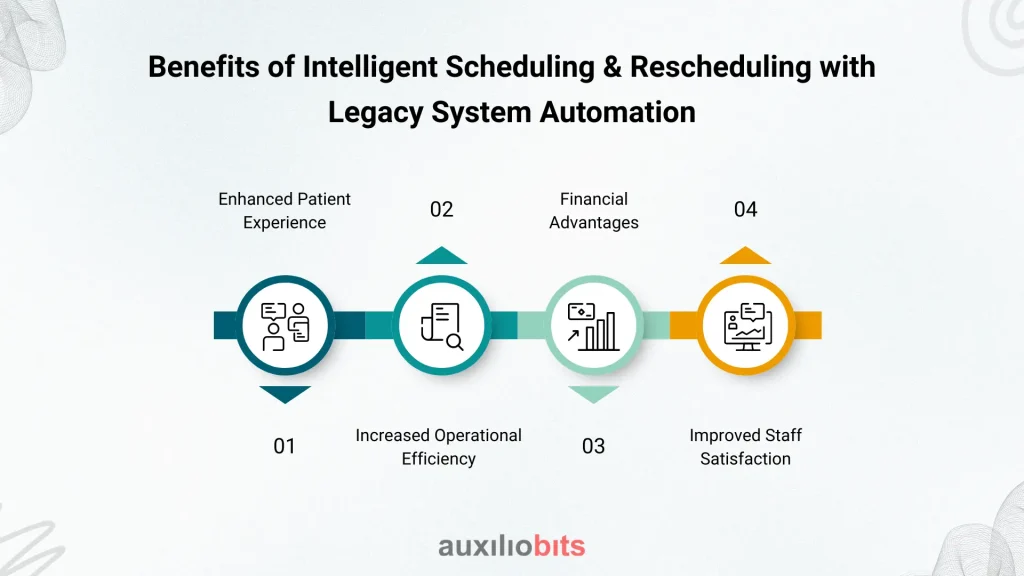
Key Takeaways
- Clinics don’t need to replace their entire system to modernize—automation bridges the gap between old systems and intelligent scheduling platforms.
- Intelligent scheduling reduces wait times, enhances access to care, and improves the overall patient experience with tools like self-service portals and automated reminders.
- Real-time rescheduling and predictive analytics help clinics adapt instantly to changes, reducing no-shows and maximizing resource usage.
- By automating repetitive tasks, administrative staff can focus more on patient-facing responsibilities and less on tedious scheduling tasks.
- Clinics can adopt intelligent scheduling gradually—starting with high-impact areas—ensuring staff adoption, system compatibility, and steady improvement.
In healthcare, efficiency and patient satisfaction are paramount. Yet, many outpatient clinics grapple with outdated scheduling systems—often referred to as “legacy “systems”—that create bottlenecks, frustrate patients, and strain staff. Imagine a world where appointments are seamlessly managed, wait times are drastically reduced, and clinic resources are perfectly optimized. This isn’t a futuristic dream; it’s the reality that intelligent scheduling and rescheduling, powered by Legacy System Automation, can bring.
Also read: Agentic AI in Healthcare: Beyond Chatbots to Clinical Decision Support
The Pain Points of Traditional Scheduling
For years, outpatient clinics have relied on manual processes, disparate software, and, often, paper-based systems for managing appointments. While these methods served their purpose in simpler times, they are ill-equipped to handle the complexities of modern healthcare.
Consider these common challenges:
- Long Patient Wait Times: Patients often face extended wait times, both to schedule an appointment and during their clinic visit, leading to frustration and lower satisfaction.
- High No-Show Rates: Without effective reminders and easy rescheduling options, patients frequently miss appointments, resulting in lost revenue and wasted clinician time.
- Inefficient Resource Utilization: Examination rooms sit empty, specialized equipment remains underutilized, and staff workload is unevenly distributed due to rigid and inflexible schedules.
- Administrative Burden: Clinic staff spend a disproportionate amount of time on manual scheduling tasks, phone calls, and paperwork, diverting them from patient care.
- Data Silos and Lack of Insights: Information is often fragmented across different systems, making it difficult to analyze trends, predict demand, or identify areas for improvement.
- Difficulty with Rescheduling: Life happens. When patients or providers need to reschedule, the current systems often make the process cumbersome and time-consuming.
These issues not only impact the patient experience but also directly affect a clinic’s financial health and operational efficiency.
What is Intelligent Scheduling and Rescheduling?
Intelligent scheduling and rescheduling go beyond simply booking appointments. It’s a sophisticated, technology-driven approach that leverages data, algorithms, and automation to optimize the entire patient journey. Think of it as a smart brain constantly working to ensure the right patient gets to the right provider at the right time, with minimal friction.
Key aspects of intelligent scheduling include:
- Predictive Analytics: Using historical data to forecast patient demand, identify peak hours, and anticipate no-show patterns. This helps clinics proactively adjust schedules to meet real-time needs.
- Optimized Resource Allocation: Intelligently assigning rooms, equipment, and staff based on appointment type, duration, and provider availability, ensuring every resource is utilized effectively.
- Dynamic Scheduling: The ability to automatically adjust schedules in real-time as cancellations or emergencies occur, quickly filling open slots with waitlisted patients.
- Automated Communication: Sending personalized appointment reminders via SMS, email, or even voice calls significantly reduces no-show rates.
- Self-Service Portals: Empowering patients to book, reschedule, or cancel appointments online, offering convenience and reducing administrative workload.
- Provider Preferences Integration: Considering individual provider preferences, work-life balance, and specialties when creating schedules, leading to higher staff satisfaction.
The Power of Legacy System Automation
Many healthcare organizations recognize the need for modern scheduling solutions but face a significant hurdle: their existing “legacy systems.” These are often old, deeply ingrained software applications that, while still functional, lack the flexibility, connectivity, and advanced features of newer technologies. Replacing them entirely can be a daunting, expensive, and disruptive undertaking.
This is where Legacy System Automation becomes a game-changer. Instead of a complete rip-and-replace, automation allows clinics to build a bridge between their valuable existing data and the new, intelligent scheduling capabilities.
Here’s how Legacy System Automation works for intelligent scheduling:
- Integration through APIs and Middleware: Rather than discarding old systems, automation solutions can integrate with them using Application Programming Interfaces (APIs) or middleware. This allows for seamless data exchange between the legacy system (which might hold patient records or billing information) and the new intelligent scheduling platform.
- Robotic Process Automation (RPA): RPA bots can mimic human actions to interact with legacy systems, automatically inputting or extracting data, bridging gaps where direct API integration isn’t feasible. For instance, an RPA bot could pull patient demographics from an old system and populate them into a new scheduling interface.
- Phased Modernization: Automation enables a gradual transition. Clinics can automate specific scheduling workflows first, demonstrating value and building confidence before undertaking more extensive modernization efforts.
- Data Synchronization: Ensuring that data remains consistent and up-to-date across both legacy and new systems, preventing errors and improving data accuracy.
- Improved Data Accessibility: By automating data flow, clinics gain a unified view of patient and appointment data, which is crucial for predictive analytics and informed decision-making.
Benefits of Intelligent Scheduling & Rescheduling with Legacy System Automation
The combination of intelligent scheduling and legacy system automation delivers a robust set of benefits for outpatient clinics:

- Reduced Wait Times: Smarter scheduling means less time waiting to be seen.
- Convenient Self-Service: Patients can book and manage appointments at their leisure, 24/7.
- Personalized Communication: Timely reminders and easy rescheduling options improve patient engagement.
- Improved Access to Care: More efficient scheduling means more available appointments, improving patient access to necessary services.
- Minimized Administrative Overhead: Automation handles repetitive tasks, freeing up staff to focus on higher-value activities and direct patient care.
- Optimized Resource Utilization: Maximize the utilization of examination rooms, equipment, and staff to achieve greater throughput.
- Reduced No-Shows: Automated reminders and dynamic scheduling dramatically reduce missed appointments.
- Streamlined Workflows: Eliminates manual errors and ensures a smoother, more predictable daily operation.
- Increased Revenue: Fewer no-shows and optimized scheduling result in more patient visits and improved revenue capture.
- Cost Savings: Reduced administrative labor costs and improved resource efficiency contribute directly to the bottom line.
- Data-Driven Decisions: Access to valuable insights enables clinics to make informed decisions that improve profitability and patient care.
- Reduced Burnout: Spending less time on frustrating manual tasks and more time on patient interaction leads to a happier, more engaged workforce.
- Balanced Workloads: Intelligent systems can help distribute patient load more evenly among providers.
- Focus on Patient Care: Staff can dedicate more time to what truly matters – delivering quality healthcare.
Embracing the Future: A Step-by-Step Approach
For outpatient clinics looking to implement intelligent scheduling and leverage legacy system automation, a structured approach is key:
- Assess Your Current State: Understand your existing scheduling processes, identify pain points, and map out your legacy systems to inform your future planning.
- Define Your Goals: What do you hope to achieve? (e.g., reduce no-shows by X%, decrease wait times by Y minutes, improve patient satisfaction scores).
- Choose the Right Technology Partner: Look for vendors with expertise in intelligent scheduling, healthcare-specific solutions, and proven experience integrating legacy systems.
- Prioritize Automation Opportunities: Start with high-impact, low-complexity areas where automation can quickly demonstrate value.
- Implement in Phases: Roll out new features gradually, allowing staff and patients to adapt and adjust.
- Train Your Team: Ensure your staff is comfortable and proficient with the new system.
- Monitor and Iterate: Continuously track performance, gather feedback, and make adjustments to optimize the system.
Conclusion
Intelligent scheduling and rescheduling, powered by strategic Legacy System Automation, is no longer a luxury but a necessity for outpatient clinics aiming for excellence. By moving beyond the limitations of outdated systems, clinics can unlock unprecedented levels of efficiency, enhance the patient experience, empower their staff, and ultimately, deliver better healthcare outcomes. The time to embrace this intelligent revolution is now.








